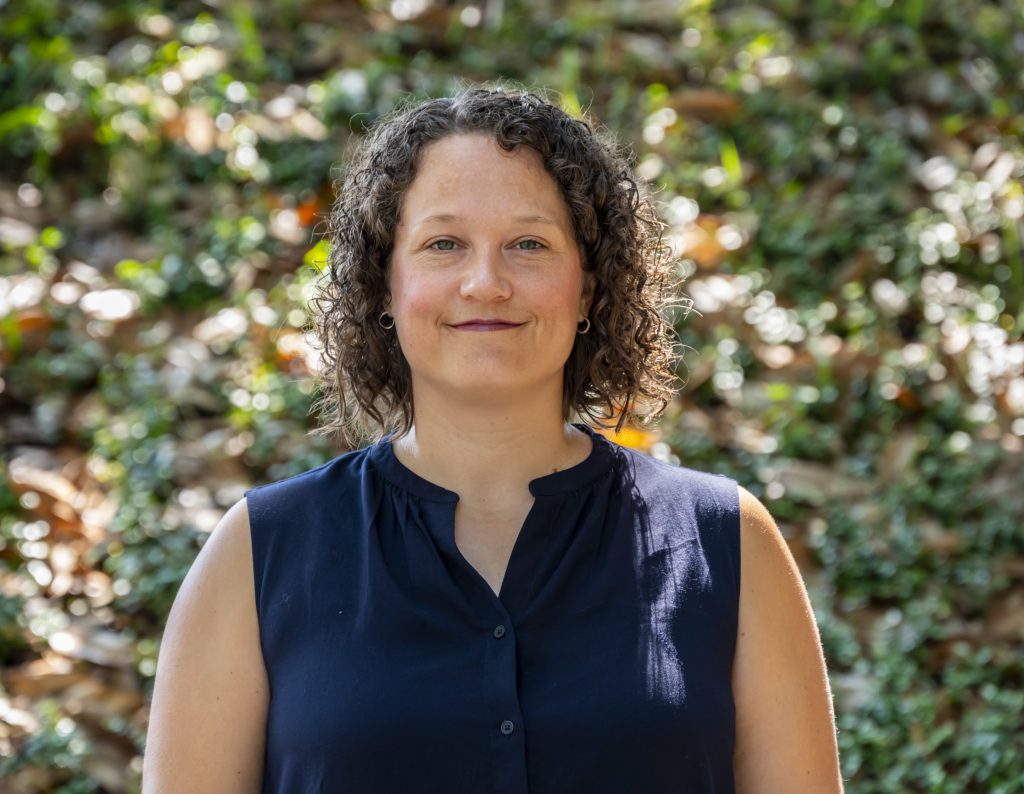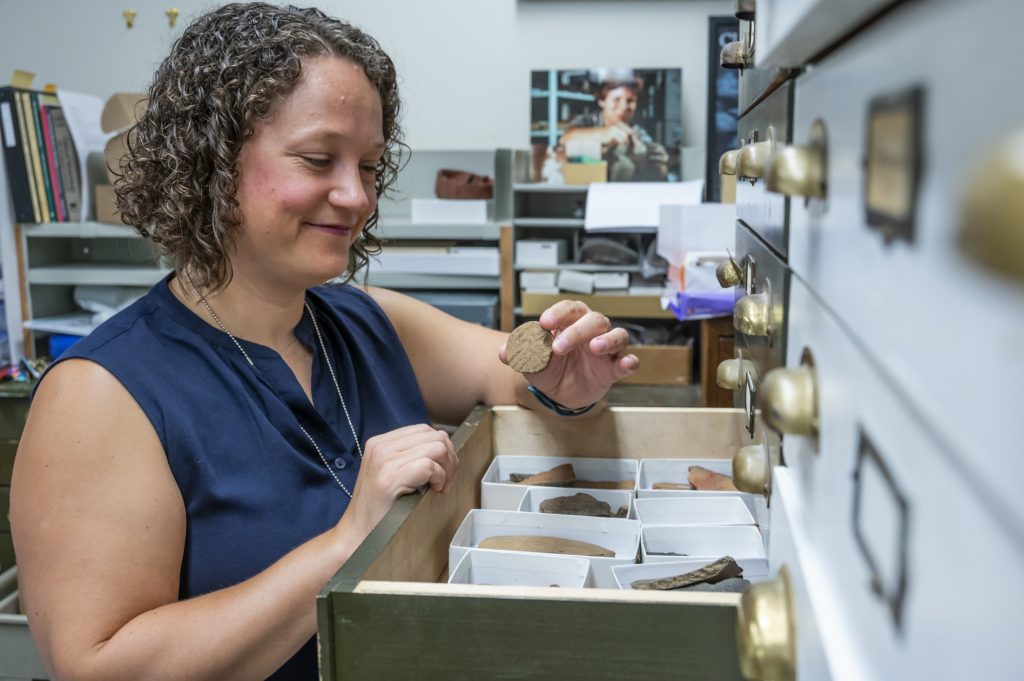Earlier this year, the Florida Museum of Natural History welcomed Andrea Torvinen as the collections manager of the Ceramic Technology Laboratory and Florida Archaeology.
Since 2005, Torvinen has worked as an archaeologist on projects in West Mexico and the U.S. Southwest, as well as Illinois and Iceland. She specializes in using pottery to study the social identity and community resilience of past societies and is eager to begin researching sites in the Southeast with her new appointment at the Florida Museum.
Pottery is a natural vehicle for answering the theoretical questions Torvinen is interested in, such as how people identify with and learn from one another.
“There are two main ways we identify socially,” Torvinen said. “One is our social networks, like who we engage with on a regular basis. And then there are larger social categories, like where we work, that we can identify with. Those are all things that are captured in pottery.”

Florida Museum Photo by Jeff Gage
Typically, Torvinen said, people start out making pots with the techniques they are taught as apprentices, which archaeologists can observe in the paste recipes or forming methods used. Over time, however, potters can be influenced by different social or economic factors that result in different shapes or decorative styles, while raw materials and construction techniques stay the same. Changes like these could indicate shifts in the person’s social identity during their life.
In modern times, clothing and accessories play a similar role in social identification. “If I had an Arizona State sticker, you would assume I’m a Sun Devil or at least a fan,” Torvinen said. “It’s the symbology we use to mark ourselves.”
Torvinen received her bachelor’s degrees in anthropology and geology from Albion College in Michigan. Her interest in past civilizations began in childhood, when she watched Indiana Jones and visited archaeological sites in the Yucatán Peninsula during family vacations. “It was fascinating to be walking around where people a couple hundred years ago were living a completely different sort of life,” she said.
During her doctoral program at Arizona State University, she worked on the La Quemada archaeological site in Zacatecas, Mexico — a dynamic and understudied settlement from Mesoamerica’s epiclassic period (600-900 C.E.). Other sites in the area carried on through the postclassic period (900-1200 C.E.) and beyond. La Quemada, however, faded surprisingly early.
“The height of its occupation was from 600 to 800 C.E.,” Torvinen said. “Other people had already ruled out environmental factors like changes in rainfall. So, I was trying to see if there was a breakdown in social identity that contributed to the site’s decline and abandonment.”
Torvinen’s doctoral advisor, Ben Nelson, had worked at the site since the 1980s and brought her on the project to examine the ceramics for clues. Many pottery styles were shared across the region, but archaeologists were unsure whether the objects were moving or if people were copying styles they saw elsewhere. One part of Torvinen’s dissertation, which refined the chronology of the site by tracking the rise and fall of different pottery styles over time, was the first such study done at La Quemada and allowed archaeologists to evaluate changes in social and behavioral patterns over time at the site.
It remains a mystery why the site of La Quemada lasted only 200 years. Torvinen’s suspicion, however, is that there was something outside pulling residents away, rather than something about the settlement pushing them out. That era in Mesoamerica saw the rise of trade networks that connected other areas of West Mexico with Central Mexico. “La Quemada was just a little too far north, a little too off the beaten path to participate in those interregional connections,” she said. “So maybe people moved further south to engage with that.”

Florida Museum Photo by Jeff Gage
For two years after completing her doctoral degree, Torvinen stayed on at ASU as a postdoctoral associate to manage the project collections housed in Zacatecas, Mexico, and organize a workshop with all the researchers who had worked on the La Quemada-Malpaso Valley archaeological project during its roughly 30-year existence. The information gathered from that workshop will be synthesized into a Spanish report for the Mexican government and an English edited volume.
Later, as a National Science Foundation postdoctoral associate at ASU, Torvinen worked with Kostalena Michelaki to launch the Pan-American Ceramics Project, an open-access database for pottery across the Americas. Torvinen said the idea began during her dissertation research, as she noticed there was no easy way to track the similarities among pottery in different regions. As a result, archaeologists often used different names for what could be considered the same thing. The database, which officially launched in December 2022, offers a way to integrate data across projects and regions.
“I hope pulling pottery from Florida, Mexico and Canada, for example, all together in one place can eventually help us see wider scale patterns we never thought possible before,” Torvinen said. At the Florida Museum, she plans to continue adding to the database — perhaps gathering enough data in the future to make comparisons across continents.
Torvinen will also be working with the museum’s associate curator of Florida Archaeology, Neill Wallis, on a collection of shell tempered pottery, a tradition within the Mississippian culture. She’s eager to brush up on her petrographic microscope skills, which she will use to examine the microtexture and material components of pottery samples across sites to see which traits are shared.
“Can we learn anything about how people interacted in different ways in the past? Are these regional styles only produced locally and shared, or is there any physical movement of the actual pottery? It’s very much in line with what I was already doing. And it’s exciting.”
Source: Andrea Torvinen, a.torvinen@floridamuseum.ufl.edu
Writer: Jiayu Liang, jiayu.liang@floridamuseum.ufl.edu, 352-294-0452